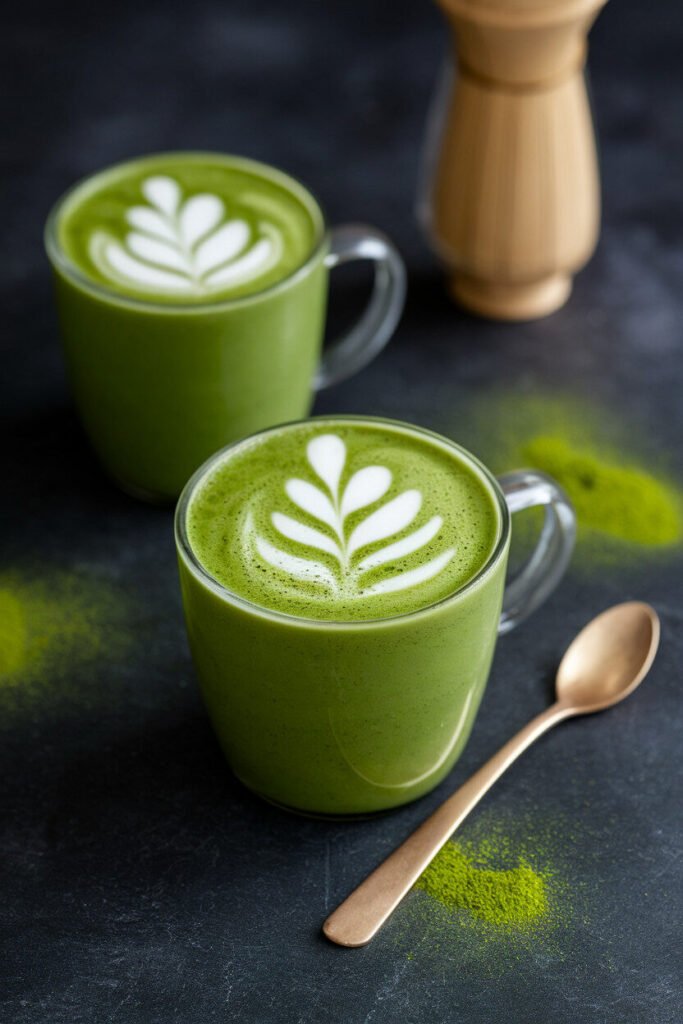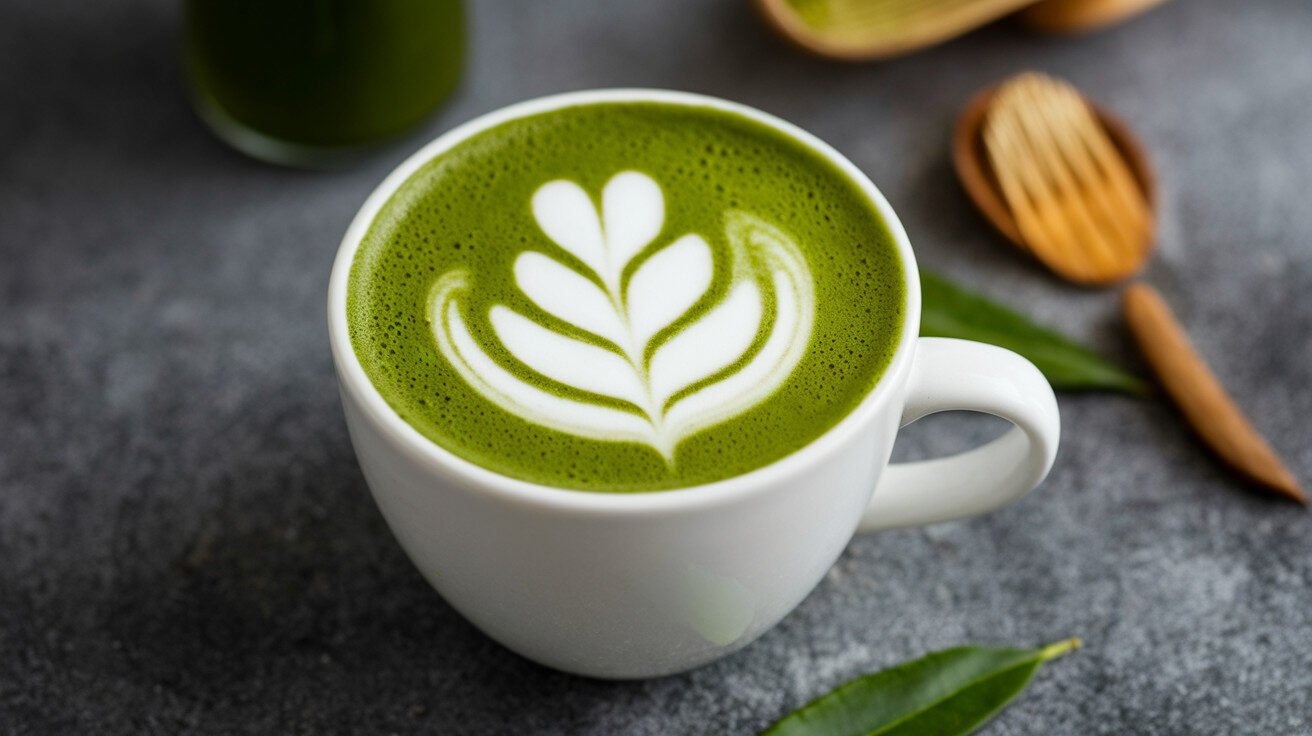You know what frustrates me about most keto recipes? They treat ingredients as interchangeable when they’re absolutely not. The quality of your matcha powder alone can make or break this entire recipe – and I’ve tested this across dozens of brands at different price points.
Ingredients for the Perfect Keto Matcha Latte

Core Ingredients and Nutritional Breakdown
Here’s your shopping list with precise measurements – and I mean precise, because eyeballing this will wreck your macros:
- 1 teaspoon ceremonial grade matcha powder (about 2g)
- 1 cup unsweetened almond milk (240ml) – though I sometimes prefer macadamia milk for creaminess
- 1 tablespoon MCT oil (15ml) or 2 tablespoons heavy cream
- 1-2 teaspoons erythritol or monk fruit sweetener
- ¼ teaspoon vanilla extract (optional but recommended)
- Pinch of Himalayan pink salt (trust me on this)
Now the nutritional math – because you’re probably tracking this in Cronometer like I do: Approximately 120 calories, 1g net carbs, 12g fat, 2g protein. The variance comes from your milk choice and whether you use MCT oil versus heavy cream. I’ve found heavy cream gives a richer texture but MCT provides those quick ketones.
Ingredient Quality: Sourcing Premium Matcha and Fats
Look, I’ve made this mistake so you don’t have to: culinary grade matcha in a latte tastes bitter and grassy. The heating process amplifies those flavors. Ceremonial grade has smoother, umami notes that stand up to warming.
For fats – this is where people mess up their keto ratios. MCT oil gives quick energy but can cause… digestive issues if you’re not adapted. Heavy cream is more stable but higher in calories. Honestly? I keep both on hand and switch based on my energy needs that day.
The milk alternative matters more than you’d think. Almond milk is standard, but macadamia milk has better fat content and fewer additives in most brands. I avoid coconut milk here – it overpowers the matcha’s delicate flavor.
Step-by-Step Preparation Instructions
Essential Equipment for Optimal Texture
You don’t need fancy gear, but you do need the right tools. I’ve tried every method imaginable, and here’s what actually works:
A bamboo matcha whisk (chasen) is ideal, but a small electric milk frother works surprisingly well. A regular whisk? You’ll get clumps. A blender? Overkill and too much cleanup. I keep a $15 frother in my kitchen specifically for this recipe – it’s worth the investment.
The Traditional Whisking Method
This is my preferred approach when I have an extra minute. It’s meditative, honestly.
First, sift your matcha powder into a bowl. Don’t skip this – clumpy matcha is the worst. Add about 2 tablespoons of warm (not boiling!) water. The water temperature is crucial – around 175°F max. Boiling water makes matcha bitter.
Now whisk in a “W” or “M” motion until frothy. This should take about 30 seconds. Meanwhile, heat your milk alternative to the same temperature. Pour the matcha into your mug, then add the warmed milk and fats. Sweeten to taste.
The Quick Blender Method
When I’m rushing out the door, this is my go-to. All ingredients go into a blender – cold. Blend for 20-30 seconds until frothy, then pour into a mug and microwave for 60-90 seconds. It’s not traditional, but it works surprisingly well.
The key here is blending cold then heating. If you heat first then blend, you’ll have a mess. Learned that the hard way.
Advanced Keto Matcha Customization Techniques
Flavor Variations and Add-In Combinations
After making this daily for years, I’ve experimented with every variation imaginable. Some winners:
- Chai-spiced: Add ¼ teaspoon cinnamon, pinch of cardamom, and tiny pinch of cloves
- Mocha: 1 teaspoon cocoa powder with your matcha – use a bit more sweetener
- Golden: ¼ teaspoon turmeric and pinch of black pepper (helps absorption)
- Protein boost: 1 scoop collagen peptides blends beautifully
The collagen addition is something I recommend to clients regularly. It doesn’t alter the flavor much but adds 10g protein.
Troubleshooting Common Texture and Taste Issues
If your latte is clumpy, you’re either not sifting the matcha or your liquid is too hot. If it’s too thin, you need more fat content – try heavy cream instead of MCT oil. Too bitter? Your matcha quality might be the issue, or you’re using boiling water.
I can’t emphasize enough how much the water temperature matters. I use a thermometer religiously for this – 175°F is the sweet spot.
Frequently Asked Questions
How many net carbs are in this keto matcha latte?
Typically 1g net carb, but it depends on your milk choice. Almond milk usually has 1g net carb per cup, while macadamia milk can be as low as 0.5g. The matcha itself has about 0.5g net carbs per teaspoon.
Can I make a keto matcha latte without special equipment?
You can, but the texture suffers. A jar with a tight lid and vigorous shaking works in a pinch. I’ve done this when traveling – it’s better than nothing but not ideal.
What’s the difference between ceremonial and culinary grade matcha for keto?
Ceremonial grade is stone-ground from younger leaves, giving it a smoother, less bitter flavor. Culinary grade comes from older leaves and is better for baking where other flavors dominate. For drinking straight, ceremonial is worth the extra cost.
Which keto sweetener works best in a matcha latte?
Erythritol or monk fruit blends work well. Stevia can have a bitter aftertaste that clashes with matcha. Allulose works but makes the latte slightly thinner. I prefer erythritol for its neutral flavor and texture.
How does matcha support ketosis and energy levels?
Matcha contains L-theanine, which provides calm energy without jitters. The caffeine content is lower than coffee but more sustained. For keto, it’s perfect because it doesn’t spike blood sugar like many other caffeine sources might.
Can I use dairy-free alternatives in this recipe?
That’s what I’ve recommended throughout! Almond, macadamia, coconut – all work. Just check the carb counts. Some oat milks are too high in carbs for strict keto.
How should I store and reheat leftover keto matcha latte?
Honestly? Don’t. The fats can separate and it never tastes right. This is best fresh. If you must, shake well before reheating gently.
